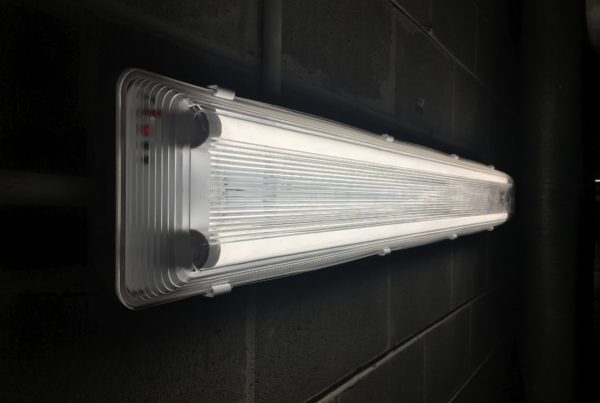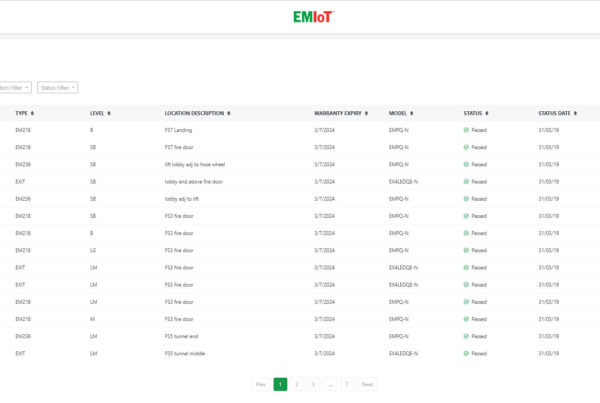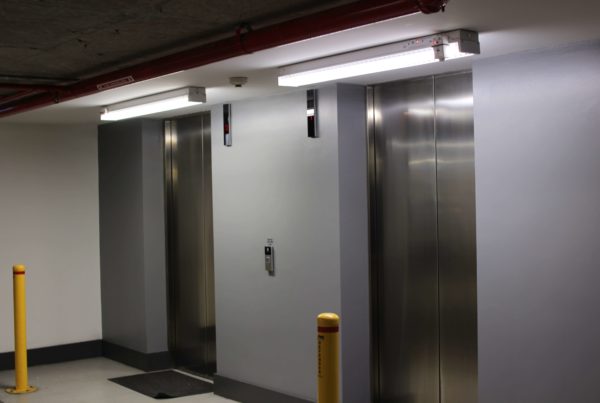Today’s building architecture can make us marvel at its intricacies and astound us with the technologies needed to provide comfort. The development of emergency lighting further demonstrates how buildings can digitally transform to achieve cleaner and smarter cities.
Schraft notes that “Lighting is the ideal orchestrator of smart technology; it is fixed, has a constant power source and can easily be installed without causing disruption to building occupants.”
Lighting itself will become more technologically advanced because software and services used for storing, processing and analysing the sensor data collected, this has helped emergency lighting transform to what it is today and continue to help the innovate of the industry in the future.
“As demand for smart devices increases, including lighting, the cost base will fall and the market will reach a tipping point where wholesale adoption takes place. At this point, the promise of a new industrial revolution will really take place.” – Schraft
In any study of emergency lighting, the debate on the type of lights that perform efficiently usually comes up. Some people prefer fluorescent lights while others LED lighting. However in recent times, many have concluded that the latter offers better services than the regular fluorescent.
This article will show you why LED technology has the upper hand over fluorescent technology when it comes to emergency lighting. We will also show you the benefit of using LEDs for emergency lighting.
Clear Comparison between LEDs and Fluorescent Technology
Unless you have a career in the lighting industry, telling the difference between tubular LED lighting and the fluorescent type might prove difficult. This similarity exists because both bulbs share a familiar physical look. However here are the significant discrepancies between both types of light.
LED vs. fluorescent: Which Lasts Longer?
All lamps have life expectancies. This is the period it takes before failure and has its value determined in hours. For T5 fluorescent luminaries under constant lighting conditions, it’s lifespan may range from 15000-30000 hours which translates to 1.7 to 3.4 years.
Alternatively, LED luminaries to have an unequal advantage of running for more extended periods. These lamps can work between 50000 to 100000 hours which is 5.7 or 11.4 years with uninterrupted use. In summary, LEDs have a more impressive life expectancy than fluorescent tubes.
Furthermore, T5 fluorescent technology uses electronic ballasts, unlike the previous fluorescent technologies which make use of traditional mechanical ballast. On the other hand, LED technology uses a new component in the form of a LED driver.
However, the varying level of the quality of LED drivers and electronic ballasts, could lead to an extra component with an uncertain life expectancy causing a total replacement of the light fittings. Hence, users should consider the quality and lifespan of the product when looking for suitable lighting technology.
LED or fluorescent: Cost?
When it comes to choosing the economical forms of emergency lighting, LED comes up as a pertinent option. It stands as a worthy choice because; it has a longer life than regular fluorescent technology. When it comes to emergency lighting, the cost of the product has to be taken into consideration. In this case, one shouldn’t only look at the expense of purchase, but to also consider the annual functional costs. LED luminaires for commercial purposes come with an increased price. However, the features of lower operational costs and long life make fluorescent less favourable.
LED Are More Efficient Than Fluorescent Bulbs
Research has shown that LED lights have a higher degree of efficiency than fluorescent lights. Results from an energy conservation study showed that LED was more efficient because of no loss on the side of the lamp. Furthermore LED lights consumed less power and had a longer lifetime than other types (Prasopsuk, C. et al., 2018).
Another study on the use of 6 watts LED lamps for approximately 5.93 hours showed about 66.12% in energy savings. These lights replaced the use of 13-watt compact fluorescent (Supawong, U. et al., 2016).
Directional Light Source
Bulbs with LED technology emit light in a 110-degree pattern unlike the 360-degree pattern related to fluorescent lamps. However, with tubular fluorescent lighting, only a fraction (about 30%) of the light discharged hits the expected target. This shows that we do not use all the light from fluorescent bulbs since they also brighten the fixture. (baylighting.net/8-reasons-consider-led-replacement-bulbs-vs-t8-fluorescent-bulbs/)
Brightness
Unlike fluorescent bulbs which “burn out” or die over time, LED lights maintains its brightness over a more extended period. This happens because of lumen depreciation, i.e, slow dimming of LED light intensity.
Heat
LED lighting products emit light through its energy. On the other hand, fluorescent lamps use heat to produce light thus making it unpopular with homeowners.
Impact on the Environment
We can see another difference in the presence of mercury in fluorescent bulbs. According to Aucott et al. (2003), a discarded fluorescent bulb releases tons of toxic Mercury gas into the air when it get broken. This action pollutes the environment. However, LED lights contain no glass or mercury making it a safer lightning alternative (Stevens R et Motta M, 2018).
Colour Rendering
LED light matches natural sunlight. This resemblance occurs because the LED chips contain representations of all colours displaying the brightest white. It also emits each colour like sunlight. However, fluorescent light has a lesser rendering and cannot imitate sunlight due to the spiking of its wavelength at specific colours.
Benefits of Using LED Technology for Emergency Lighting
With the earlier mentioned advantages of tubular LED lighting, questions on the benefits of LED as an ideal light source for emergency lighting should come to mind.
LED lights practically meets the criteria for every photometric parameter. The end of life of LED lighting stands as an advantage coupled with the amazing ability to conserve energy. Furthermore, LED has become popular with designers and architects due to its association with sleeker forms of emergency lights which perform efficiently.
Now let’s go further and see how LED enables emergency lightning and what makes it the best choice for installers and users alike.
Cheaper Long-Term Cost
When compared to other sources of lights, LED may seem at a disadvantage due to the cost of installation. However, when the whole life cost comes into consideration, LED has the higher ground. For instance, comparing a regular 8W maintained self-contained bulkhead with LED of the same watt, then the cost comparison ratio falls in the order of 1:2 or1:4 respectively.
A critical look at the cost of replacing the lamp and batteries of both light sources over an eight-year period also makes LED a suitable alternative. Both light sources require a battery replacement during this period; however, the 8W fluorescent bulkhead would need a change of bulbs a couple of times. This requirement burns a hole in the pocket of users as each lamp change equals the initial cost of the bulkhead from expensive labour and call out fees.
Make Safety Top Priority
Locations that have so many infrastructures such as underground car parks, around or within buildings require the presence of emergency lighting. Emergency lights allow the quick and safe movement of people during a hard time like fire outbreaks. Thus, the presence of suitable exits light signs indicates the exit route to prevent panic.
In recent times, LED modules which can replace fluorescent luminaries have become popular with both installers and users alike. These lights have low cost and efficient features which makes it a highly sought item in the emergency lighting industry.
With so much positive attributes of LEDs systems, the technology has the potential to stand as the ideal light source. Since it contains no environmental toxins such as lead or mercury, LED lamps do not have any negative impact on the environment. Furthermore, its non-volatile nature makes it a worthy material in environments considered as explosive, e.g. mines and oil rigs.
Due to its energy efficiency, LED luminaries can work from backup batteries or generators that start when there is a power failure. LED lamps act as point light sources hence, it’s easy to direct it to where it is needed. A combination of this capability with its high optical efficiency increases its energy efficiency.
Conserves Energy
LED-based emergency lights also have an advantage when it comes to energy consumption. LED lamps consume only a portion of the energy required by fluorescent technology, with the abilities to further reduce energy consumption with smart dimming technology.
Does Not Require as Many Replacements As Fluorescent Lights
As previously mentioned, the cost of changing the lamp of an 8W fluorescent emergency lights surpasses the cost of installation considering the labour involved. Alternatively, LED-based lights do not need as much changing during its lifetime.
Moreover, before fluorescent lights reach their end of life, they diminish over time producing less than their rated output. However, with LED, the degradation comes at a slower pace making it essential for emergency lighting.
Provide Increased Illumination of High-Risk Task through Light Control
As we all know LED offers directional light thus making the distribution of light more straightforward to handle. This control allows light to move to where its needed such as escape routes and open areas.
Reduce the Heat of the Emergency Lights
With additional improvements in the efficiency of LEDs, heat production by these devices becomes less. Similarly, the current trend of using more mid-level powered LEDs as against ones with high power also reduces the heat produced. The production of less heat makes LED suitable for self-contained lights by keeping the batteries cooler thus ensuring longer product life.
Provide Better Light Quality
When searching for an ideal light source for emergency lighting, light sources with colour rendering index (CRI) greater than Ra 40 perform well. With such low requirements, we can see that the quality of light for emergency lighting should not necessarily have high standards. However, with mains lighting requiring better light quality, tubular LED lighting with higher CRIs exist thus addressing this need.
Having seen the importance of LED as a light source for emergency lighting, let’s also look at its relevance (LED lights) to smart buildings.
Benefits of LED Technology towards Smart Building
LED lights can serve as a means of digital communication and create a cabless smart building network, as seen in WBS Technology’s EMIoT solution.
Here are some of the ways smart LED lighting can benefit various structures with the help of IoT connectivity.
- Improves Both Public And Home Security
Chaflin et al., 2017 pointed out that lighting can reduce crime by 39 percent. This makes the utilisation of smart LED lighting a relevant measure for improved safety. Street lights with LED technology can help create a network that allows the use of captured data for intelligent and extensive surveillance.For example, In Los Angeles, smart streetlights have helped bring down crime rates by more than 10% for offences related to vehicle theft, burglary, and vandalism. (https://internet-of-things-innovation.com/insights/the-blog/smart-lighting/#.W6ZPW8vTXqA ) - Helps Increase Energy Efficiency
Structures with traditional lighting sources need to switch to smart LED lighting systems to meet the continually changing needs of its occupants.
Integrating LED lighting systems with IoT creates excellent chances for budget management and energy conservation. Reduced power usage cuts costs which benefit both homes and office buildings. The use of LED also reduces cases of greenhouse gas emissions.
Final Word for You
Lighting plays a significant role in modern architecture with LEDs and fluorescent lights serving as the potential choice for builders. Although fluorescent lights cost less, LEDs have a reduced maintenance cost, emit less heat, contain no toxins and use less energy. These features amongst others make LED lamps ideal for use as emergency lighting.
LEDs also have the advantage of easily integrating with wireless technology to form a network with various devices to create a smart lighting system. Smart LED light systems still have a lot to play in the building industry. They include ensuring energy efficiency, security and predictive maintenance amongst others.





